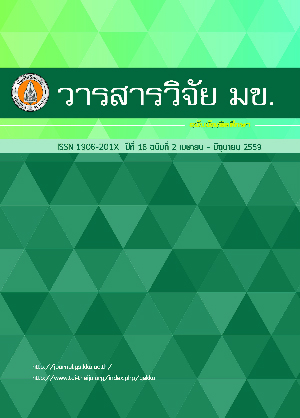สมบัติบางประการทางอุทกวิทยาของดินและสัตว์หน้าดิน ในพื้นที่การใช้ประโยชน์ที่ดินที่แตกต่างกัน บริเวณพื้นที่ลุ่มน้ำย่อยห้วยขมิ้น จังหวัดนครราชสีมา (Some Soil Hydrological Properties and Soil Macrofauna in Various Land Use Types at Huai Khamin Subwatershed, N
Keywords:
สมบัติทางอุทกวิทยาของดิน (Soil hydrological properties), สัตว์หน้าดิน (Soil macrofauna), การใช้ประโยชน์ที่ดิน (Land use)Abstract
บทคัดย่อ
การวิจัยครั้งนี้มีวัตถุประสงค์เพื่อศึกษาและเปรียบเทียบสมบัติทางอุทกวิทยาดินบางประการและสัตว์หน้าดินในพื้นที่การใช้ประโยชน์ที่ดินที่แตกต่างกัน นอกจากนี้ เพื่อศึกษาความสัมพันธ์ระหว่างสมบัติทางอุทกวิทยาดินบางประการกับจำนวนสัตว์หน้าดิน โดยพื้นที่ศึกษาประกอบด้วย พื้นที่ป่าเบญจพรรณ พื้นที่ป่าดิบแล้ง พื้นที่ป่าฟื้นฟู อายุ 20 ปี พื้นที่ป่าฟื้นฟู อายุ 3 ปี และพื้นที่เกษตรผสมผสาน จากการศึกษา พบว่า เนื้อดินบนทั้งหมดของพื้นที่ศึกษาเป็นดินร่วนเหนียวปนทราย และส่วนใหญ่มีเนื้อดินชั้นล่างที่แตกต่างกัน ความหนาแน่นรวมของดิน พบว่า มีค่าสูงสุดในพื้นที่เกษตรผสมผสาน เท่ากับ 1.44 กรัมต่อลูกบาศก์เซนติเมตร และมีค่าต่ำสุดในพื้นที่ป่าดิบแล้ง ซึ่งตรงกันข้ามกับค่าความพรุนของดิน ส่วนค่าความชื้นในดินเฉลี่ยสูงสุดพบในพื้นที่ป่าฟื้นฟู อายุ 3 ปี มีค่าอยู่ในช่วงร้อยละ 18.69 - 26.88 และค่าความชื้นในดินต่ำสุดพบในพื้นที่เกษตรผสมผสาน ในขณะที่อัตราการซึมน้ำผ่านผิวดินคงที่มีค่าสูงสุดในพื้นที่ป่าดิบแล้ง เท่ากับ 213 มิลลิเมตรต่อชั่วโมง และอัตราการซึมน้ำผ่านผิวดินคงที่มีต่ำสุดในพื้นที่ป่าฟื้นฟู อายุ 3 ปี นอกจากนี้ พบว่า ค่าความหนาแน่นรวมของดิน และความพรุนรวมของดินในพื้นที่การใช้ประโยชน์ที่ดินที่แตกต่างกันมีความแตกต่างกันอย่างมีนัยสำคัญทางสถิติทั้งดินชั้นบนและชั้นล่าง ส่วนความชื้นในดินพบความแตกต่างกันเฉพาะในดินชั้นล่างเท่านั้น ในส่วนของสัตว์หน้าดินพบทั้งหมด 58 ชนิด 30 วงศ์ 17 อันดับ และมีความหนาแน่น เท่ากับ 1,106 ตัวต่อตารางเมตร ส่วนดัชนีความหลากหลายและดัชนีความมากมายของสัตว์หน้าดินมีค่าสูงสุดในพื้นที่ป่าดิบแล้ง มีค่าเท่ากับ 2.58 และ 5.78 ตามลำดับ และดัชนีความคล้ายคลึงของสัตว์หน้าดินมีค่าสูงสุดในพื้นที่ป่าฟื้นฟู อายุ 20 ปี กับป่าฟื้นฟู อายุ 3 ปี สำหรับความสัมพันธ์ระหว่างสัตว์หน้าดินและสมบัติดินทางอุกวิทยาบางประการ พบว่า จำนวนของสัตว์หน้าดินมีความสัมพันธ์ไปในทิศทางเดียวกันกับความพรุนรวมของดินและความชื้นในดิน แต่มีความสัมพันธ์ตรงกันข้ามกับความหนาแน่นรวมของดิน การศึกษาสามารถนำไปประยุกต์ใช้ในการวางแผนการใช้ที่ดินอย่างเหมาะสมในพื้นที่ลุ่มน้ำ และสนับสนุนการจัดการลุ่มน้ำให้ยั่งยืน
ABSTRACT
The objectives of this research were to study and compare some soil hydrological properties and soil macrofauna in various land use types and to study the relationship between some soil hydrological properties and the number of soil macrofauna. The study sites consist of mixed deciduous forest, dry evergreen forest, 20-years-old rehabilitated forest, 3-years-old rehabilitated forest and agroforestry area. From the results of soil hydrological properties, topsoil texture of all study areas was sandy clay loam (SCL) and differed mainly in the subsoil texture. In evergreen forest area. In contrast, the overall values of total porosity were in the opposite direction. The highest average monthly soil moisture content was found in 3-years-old rehabilitated forest area ranging from 18.69-26.88% and lowest value was agroforestry area. While the infiltration rate in dry evergreen forest area was the highest value 213 mm/hr, the lowest value was found in 3-years-old rehabilitated forest area. On the statistical significance of the bulk density and total porosity in various land use types were found both topsoil and subsoil. For soil moisture content, only subsoil was significant. From the results of soil macrofauna, these were found 58 species, 30 families, 17 orders and density with 1,106 individuals/m3 in average. Diversity index and richness index were highest in dry evergreen forest area with the value of 2.58 and 5.78 respectively whereas mixed deciduous forest area showed the lowest values. As for similarity index, it was found that 20-years-old and 3-years-old rehabilitated forest areas had the highest similarity. The relationship between some soil hydrological properties and the number of soil macrofauna, it was found that the number of soil macrofauna was positively correlated with total porosity and soil moisture content but negatively with bulk density. The research results can be applied for appropriate land use planning at watershed area and for supporting sustainable watershed management.


